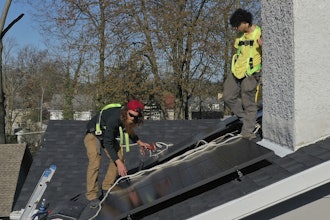It’s common knowledge that solar panels take up a lot of space. Just look at the massive solar power plantthat was turned on in February in the Moroccan town of Ouarzazate, on the edge of the Saharan desert. The plant is capable of generating up to 160 megawatts of power, but it must take up thousands of acres of land to do so.
According to engineers at Vienna University of Technology (TU Wien), there is an obvious solution to this expansive problem. The team has developed a unique concept that comes in the form of a floating platform called a Heliofloat. The platform would function as a sea-based solar power station.
According to the researchers, the main obstacle to this concept is waves, which endanger large floating installations on the water. However, a new lightweight construction has been developed at TU Wien which can be used to build platforms spanning 100 meters long, while also remaining steady and firmly in place – even in rough sea weather.
The float is designed to be covered from edge to edge with solar panels, and it can operate as a standalone platform for smaller operations with moderate energy requirements. However, multiple Heliofloats can also be connected together to form a floating solar-harvesting power grid.
Comparable to most platforms, the Heliofloat uses barrels for floatation, but what makes it unique is that each Heliofloat barrel is constructed from a soft flexible material that is open to the ocean. The upper section of the barrel contains air that can’t escape, which allows the barrel to float, while the air also makes direct contact with the water below.
The system creates an air pocket of sorts that acts as a shock absorber in tumultuous waters. Plus, the side walls of the barrels also flex when hit by waves, allowing the platform to remain stable during rough weather. In contrast, a closed-bottom platform made of rigid air-filled barrels would absorb the wave energy to a larger extent, causing the platform to sway and eventually break.
The research team at TU Wien has developed concepts for harnessing the sun over the water using photovoltaics and parabolically shaped mirrored troughs; however, the platform could perform various other applications.
According to Dr. Roland Eisl, TU Wien alumnus and Director of Heliofloat, “Heliofloat platforms offer new possibilities for desalination plants and biomass extraction processes for salt water. In hot countries, Heliofloat platforms could be utilized to protect lakes against drying up.”
Due to its promising nature, the researchers founded a spinoff company to develop the platform idea for a range of other industries. The TU Wien team is currently in discussion with potential investors and are still looking for further collaborative partners and investors interested in using the Heliofloat platforms on a large scale.






















